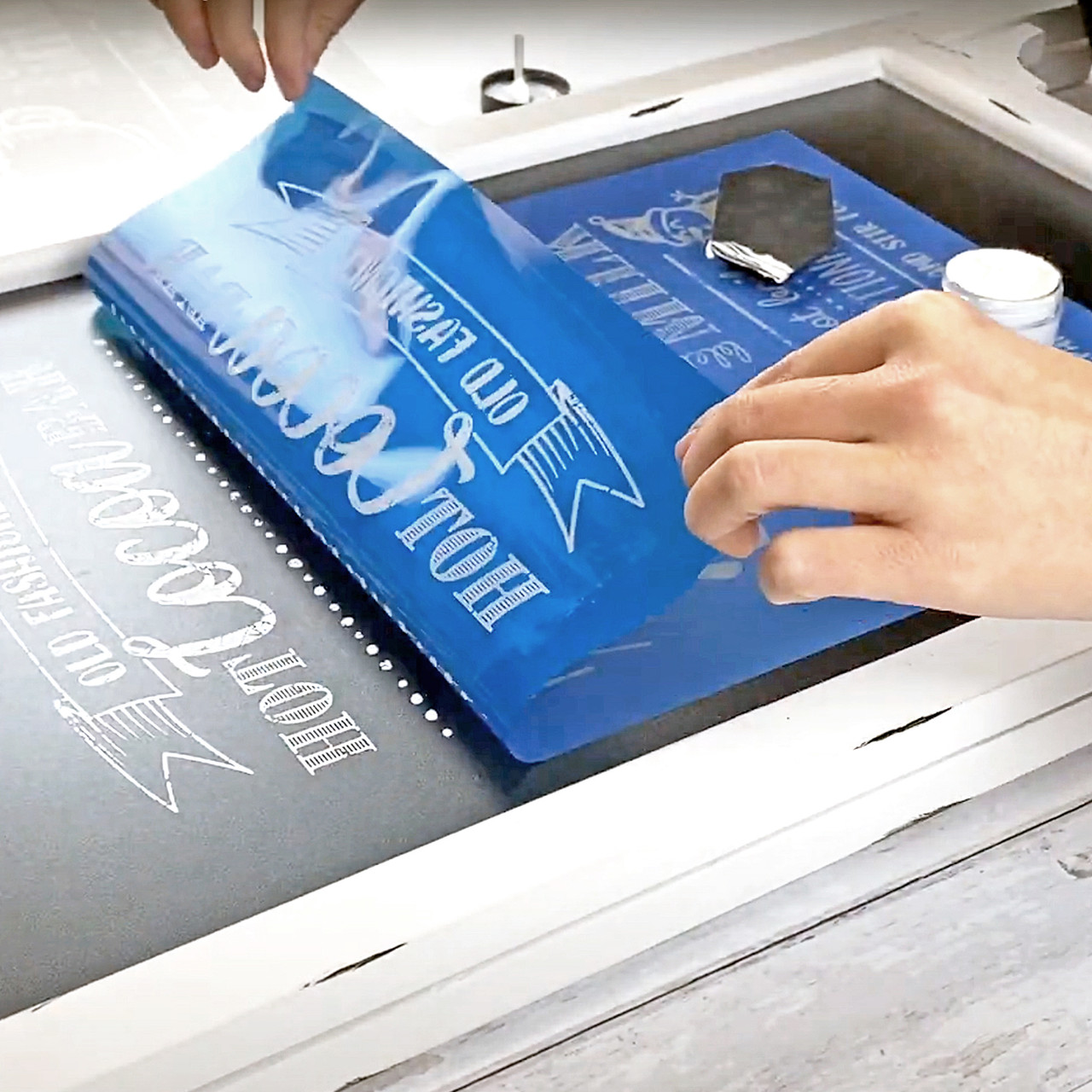High-End Silk Screen Printing for Premium Garments
Wiki Article
Display Printing Uncovered: Every Little Thing You Need to Understand About Tee and Garment Printing Techniques
Display printing is an interesting technique that incorporates art with strategy, offering limitless possibilities for creative thinking. Prepared to explore the essential elements that make screen publishing an art form?
The Fundamentals of Display Printing: Just How It Works
When you plunge into display printing, you'll discover it's both an art and a science. At its core, screen printing includes developing a pattern, or display, that allows ink to travel through only in specific areas (screen printing kit). You start by selecting your style and preparing your display with a light-sensitive solution. As soon as you reveal this solution to light, it hardens, leaving your layout as an adverse area.Following, you'll blend your inks and prepare your printing surface area. Position the screen over the material, after that utilize a squeegee to push ink through the screen onto the garment. This process needs accuracy, as you desire clear, lively prints. After printing, you'll cure the ink with warmth, guaranteeing it abides by the textile and lasts via cleans. Each step is crucial, and understanding them will certainly elevate your display printing abilities, transforming simple garments into distinct, expressive pieces.
Sorts Of Display Printing Methods
As soon as you comprehend the basics of display printing, it's time to explore the numerous methods that can elevate your designs. One prominent approach is typical display printing, where ink is pushed via a stenciled screen. This strategy is excellent for strong, lively colors. After that there's water-based ink printing, which supplies a softer feel and is eco-friendly, but it requires a various method to curing.If you're aiming for great details, take into consideration discharge printing. This strategy gets rid of dye from the fabric, leaving a soft, classic appearance. An additional alternative is plastisol printing, understood for its sturdiness and brilliant colors, making it a favored for numerous brands. Experiment with halftone printing to create slope effects and complex designs. Each technique has its special appeal, so do not be reluctant to attempt them out to discover what suits your style best!
Essential Tools for Screen Printing
To accomplish magnificent outcomes in display printing, having the best equipment is basic. First, you'll need a durable screen printing structure, which holds the mesh that transfers your design onto the garment. Next, spend in top notch squeegees; these are important for applying ink evenly throughout the display. You'll also call for a good direct exposure unit to create your screens, along with a washout booth for cleaning them after usage. A reliable warmth resource, like a conveyor clothes dryer or heat press, is crucial for curing your prints to guarantee long life. Do not neglect an appropriate work space, equipped with tables and storage space for your materials. Safety equipment, such as handwear covers and masks, will certainly keep you safe from chemicals and inks. With the right devices, you'll be well on your method to creating professional-quality prints.Picking the Right Inks and Products
When picking inks and products for screen printing, you require to take right into account the type of ink that works ideal for your task. Consider textile compatibility to guarantee your styles look fantastic and last long. Check out green ink options to make your printing process extra lasting.Kinds of Screen Inks
Choosing the best screen ink is crucial for attaining vivid, durable prints that fulfill your project's requirements. There are numerous kinds of screen inks to check out. Plastisol ink is popular for its convenience and simplicity of usage, supplying outstanding shade opacity on dark textiles. Water-based ink, on the various other hand, uses a softer feel and is eco-friendly, making it ideal for those looking to reduce their environmental impact. Discharge inks remove dye from the textile, leading to a soft, classic look but need particular handling. Specialty inks, such as glow-in-the-dark or metallic, can include distinct results to your layouts. Review your job needs and choose the ink that lines up ideal with your desired end result.
Fabric Compatibility Considerations
Recognizing textile compatibility is essential for accomplishing premium display prints, especially since different materials respond distinctively to numerous inks. Constantly test your inks on example textile to assure they adhere correctly and preserve color honesty. Furthermore, maintain in mind that material weight and appearance can impact the final result, so choosing the best ink and product combination is important for your project's success.Eco-Friendly Ink Options
Green inks are becoming a prominent selection for screen printers who desire to minimize their environmental effect while keeping high quality. When picking inks, take into consideration water-based inks, which are much less unsafe and easier to cleanse up contrasted to conventional solvents.Furthermore, search for inks made from renewable energies, such as soy or vegetable-based options. By picking the ideal inks and materials, you'll not only create spectacular styles however additionally add to a much more lasting printing procedure. Make the button, and your prints will certainly mirror your dedication to the environment!
Preparing Your Style for Screen Printing

File Layout Demands
To ensure your design looks sharp and vivid on material, you'll require to pay close focus to submit format requirements for display printing. Make certain your design has a clear history to prevent unwanted white edges on your prints. Keep shade settings in mind; CMYK is typical for display printing, so convert your RGB makes accordingly.Shade Separation Methods
Shade splitting up is a necessary step in preparing your style for display printing, and grasping it can significantly improve your print high quality. You'll need to damage your design right into individual colors, as each color needs a separate screen throughout printing. This visit site precision not only ensures exact shade depiction yet also enhances the printing procedure.Resolution and Size
Achieving the most effective outcomes in screen printing starts with guaranteeing your layout has the best resolution and dimension. Preferably, your art work should go to least 300 DPI (dots per inch) for sharp, clear prints. If you use lower resolution, your end product might look unprofessional and pixelated.When it comes to size, think about the measurements of your print area. Layout your artwork to match the final print dimension, preferably developing it in the real dimensions you'll be printing. By doing this, you'll stay clear of any kind of unanticipated scaling concerns.
Constantly check your layout in both vector and raster styles. Vector graphics can be scaled without losing high quality, making them excellent for display printing. Preparing correctly will assure your layout looks incredible on every garment!
Step-by-Step Display Printing Process
Screen printing is a vibrant procedure that enables you to produce vivid designs on various surfaces. To get begun, you'll need a screen, solution, and your chosen ink.After rinsing the unexposed solution, your screen is prepared. Establish it up on your printing surface and straighten your garment below it. Put ink onto the display and use a squeegee to push the ink with the stencil onto the material. Lift the display thoroughly and let the print completely dry. Finally, cure the ink making use of warm to ensure sturdiness. That's it! You've successfully screen printed your design.
Tips for Successful Screen Printing Projects
While you're diving right into your display printing jobs, keep in mind that prep work is vital to success. Start by collecting all your products-- inks, squeegees, displays, and garments. A tidy office helps stop unwanted mistakes, so clean before you begin.Next, verify your artwork is high-resolution and appropriately sized for your garment. Check your screen for appropriate exposure and tidy it thoroughly to stay clear of smudges. When blending your inks, adhere to the maker's standards to accomplish the appropriate uniformity.
During printing, use even stress with your squeegee for constant outcomes. Don't rush; take your time to verify each print meets your standards. After printing, allow your garments dry completely before managing or packaging them.
Lastly, constantly maintain an example of your help future reference. By doing this, you can examine your progress and improve your techniques gradually. Delighted printing!

Regularly Asked Questions
Just how Lengthy Does It Take to Establish a Display Printing Task?
Establishing a display printing task commonly takes about half an hour to an hour. You'll prepare the displays, mix inks, and change journalism. The moment differs based on complexity and experience, so remain arranged!Can I Publish on Various Fabric Keys In Utilizing the Exact Same Technique?
Yes, you can print on continue reading this different textile kinds making use of the very same method, yet you'll require to change your settings and inks. Some fabrics take in ink in a different way, so trying out guarantees the most effective outcomes for each and every product.What Prevail Mistakes to Prevent in Screen Printing?
When screen printing, avoid common mistakes like utilizing the wrong ink, try this site overlooking appropriate direct exposure times, or missing pre-press checks. Always check your arrangement and preserve clean displays to assure high quality outcomes each time.Exactly How Can I Properly Tidy and Preserve My Screen Printing Devices?
To correctly clean and maintain your display printing devices, you need to routinely wash displays with proper solvents, inspect squeegees for wear, and ensure all tools are stored dry and dust-free. Uniformity improves and prevents expensive repair work efficiency.Is Screen Printing Eco Pleasant Compared to Other Methods?
Screen printing can be more eco-friendly than various other approaches, particularly if you make use of eco-conscious products and water-based inks. By choosing sustainable products and techniques, you minimize waste and reduce your influence on the world.Screen Printing Uncovered: Everything You Required to Know About T-Shirt and Garment Printing Strategies
At its core, screen printing entails developing a stencil, or display, that permits ink to pass via only in certain areas. Placement the screen over the fabric, then use a squeegee to press ink through the screen onto the garment. One preferred method is traditional display printing, where ink is pressed through a stenciled display.When choosing inks and materials for screen printing, you require to take into account the kind of ink that works best for your project.
Report this wiki page